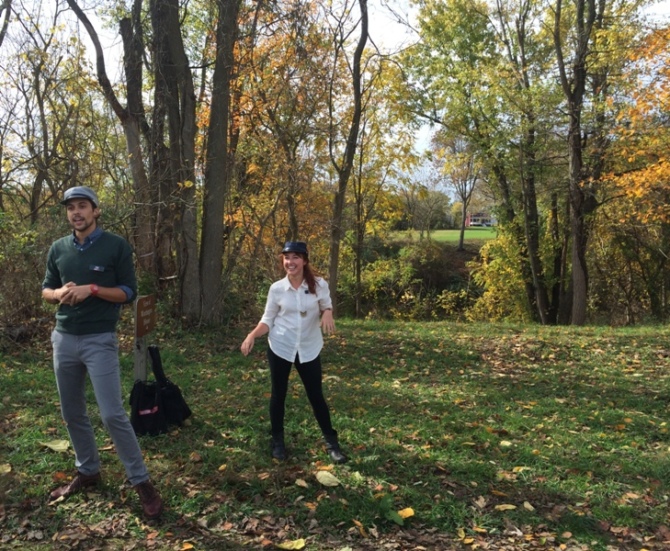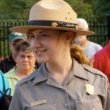Browse by Category
- All Categories
- 150th Anniversary
- Frederick County
- State Parks
- National Park Service
- Antietam
- Washington County
- Newcomer House
- 1865
- Literature
- Recreation
- Living History
- Museums
- Carroll County
- Historic Preservation
- Food/Dining
- Civil War Trails
- African American History
- Transportation
- Main Streets
- Education
- Women's History
- Geotrail
Bugle Call
Museum Hack: Relevance, Reverence, and Dance
December 3, 2015

When I think of Civil War site bread-and-butter types, I think of the hard-marching 80 visitors who spent their Mother’s Day 2014 walking 7.5 miles of the Spotsylvania Battlefield on an all-day 150th hike with me. When I think of folks who wouldn’t be caught dead on a Civil War battlefield, I think of my brother.
I once dragged him on a lengthy personal battlefield hike—a hazard of being a relative—and the results were poor. His only revelations were that terrain was somehow important, and he should never set foot on another battlefield with me again.
That mandate changed only once. He’s agreed that he will come along if I give the full tour in “gangster” speech. Between taking great pride in my vocabulary and insisting on maintaining some level of dignity in a sacred space, that tour never took place.
Needless to say, when I learned that the Heart of the Civil War Heritage Area was hosting a workshop focused on engaging millennials facilitated by Museum Hack, I thought first of my brother and the way that he finds museums, history, and historic sites to be boring and largely irrelevant. My second thought was my constant frustration at the labeling of millennials. I happen to be one, visible here in my natural habitat and miraculously free of a Snapchat addiction.
Enter Museum Hack’s enthusiastic workshop leaders, Zak and Kate. Their goals were remarkably similar to what we as interpreters express on a regular basis: help others to realize how fascinating, relevant, and applicable museums, historic sites, and the history they preserve truly are—but with a twist. Museum Hack is for the uninterested brothers of the world.
The strategies they advocated were both remarkable and sensible. Freeman Tilden famously defined interpretation as provocation fifty years ago, and the principle holds firm today. Kate and Zak championed the same methodology, choosing a Colt revolver from Monocacy National Battlefield’s exhibits to delve into the fascinating story of its founder. Next, we played a game.
Played a game? That’s right. We chose what item from the museum exhibits we would use in case of zombie apocalypse. That was the moment I realized that my brother would enjoy this program. While I wasn’t sure how it advanced our mission, I played along—and had fun.
It was all a part of what the Museum Hack folks call “scaffolding,” a means of building an experience for visitors. Most historic sites use a similar process, but the details differ. Here the key was to get a group to feel comfortable with the guides and each other. The end goal? Build participants up to connect to the guides and each other with ease, discussing artifacts and even interpreting items themselves.
We proceeded to do just that, taking our smartphones and choosing an item to research and present to the rest of the group. We followed the scaffolding formula which built a heavy-hitting presentation leading up to a “mic drop” moment intended to blow the minds of listeners. Our choices ranged from Union General Lew Wallace’s facial hair to the Confederate battle flag in the room, which was masterfully discussed by our colleagues from Antietam National Battlefield.
In a world where distractions are a constant presence for visitors of all ages, many fellow participants commented on the beauty of incorporating smartphones into the program itself—whether posing ourselves to match a historic photo or to do our own research.
In the afternoon we headed out onto the battlefield itself, where we tested the workshop’s versatility in the open landscape. Lining up the group at one of the best vantage points on the Thomas Farm, Zak and Kate had prepared a special treat: an interpretive dance. We met their first performance with a mixture of bewilderment and curiosity. How did that work? What did it mean?
Once we ran through it ourselves, we realized it was a fairly workable model of the battle. It left out critical pieces that we as interpreters cling to—human experience stories, the nuances of battle, the all-important terrain, and in the end, the significance of the battle. But, as a tool in the box, it conveyed the basic troop movements—much as a human map does, a technique that uses individuals to walk out the movements of large bodies of people.
On a basic level, it got us laughing, comfortable, and moving. Standing in a field of interpreters who are not choreographers and were likely uncomfortable with inserting dancing into a program, it fostered an appreciation of thinking outside the box. Surely we could incorporate the other heavy-hitting pieces into a program that also incorporated non-traditional techniques.
Throughout the workshop, we had several long discussions of “playing lightly with heavy things,” as Kate and Zak termed it. For non-traditional audiences, they asserted, being lighthearted helps to engage people and to convey information. Their use of irreverence is designed to draw interest and conversation—and eventually, reverence. By building interest and learning the information at hand, visitors will care more deeply and thereby bring their own reverence to the table.
Reverence through irreverence was a new principle for many of us, but the tangible structure and examples that Museum Hack provided proved to be thoughtful considerations. You may not see workshop participants using interpretive dance, the threat of zombie apocalypse, or gangster talk to entice audiences to our battlefields, but almost all participants agreed that the workshop sparked innovative and creative thinking about how we attract and engage audiences of all ages. As caretakers of hallowed ground, we are always careful to keep and to inspire reverence and respect through whatever means we use.
While there is no silver bullet to attracting new audiences, opening the door a bit wider to discussion-based, creative techniques was a breath of fresh air for workshop participants. Museum Hack has the luxury of existing on the edge of acceptability, and when tempering their methods with a backbone of traditional interpretive styles and an open mind, October’s Museum Hack workshop sparked thought, conversation, and change, even if in a small way.
As for the gangster tour, my brother is still in the market. But, a few days ago, with fifteen fifth graders cross-legged on the floor of Chatham Manor, I considered how to explain a decision by the Virginia State Supreme Court that slaves were not people and could not choose freedom if given the option from their master, a choice Hannah Coalter of Chatham attempted to will to her slaves. I let out my inner Museum Hack-er and drew them in through Coalter’s appearance: “Have you checked out her hair? Really, it’s a bonnet, but I think she should reconsider those ribbons.” Laughter erupted, and instead of a dry conversation about why slavery was bad, we started with a fashion connection, delved into the rights of a person, and ended with a better understanding of the meanings of humanity.
Look out for Museum Hack-influenced interpretive programs at Monocacy National Battlefield and the National Museum of Civil War Medicine, as well as other sites across the Heritage Area.
Images, from top:
With Monocacy National Battlefield serving as the powerful muse for our workshop, Kate and Zak stand near the view between the Thomas and Worthington Farms, home sites that became critical battle positions.
Confederate flag: What are the origins of the Confederate flag, and how did it become the symbol as we know it today? How does it mean so many things to so many people? As subject matter experts, our colleagues from Antietam adapted the Museum Hack techniques to fit a controversial artifact in the Civil War world.
While not our best angle, the interpretive dance was designed to show that some visitors can and will connect in different ways. How often do we as interpreters struggle to break down complex battle movements in a way that people are participating and understanding?
Group discussion thrived with laughter as we stood in the historic Thomas House discussing methodology for engaging different kinds of visitors—especially those who don’t connect in “normal” ways.
Hannah Coalter’s portrait: Those ribbons, really? But this is the face of a would-be emancipator, even if her will’s intention was denied.
